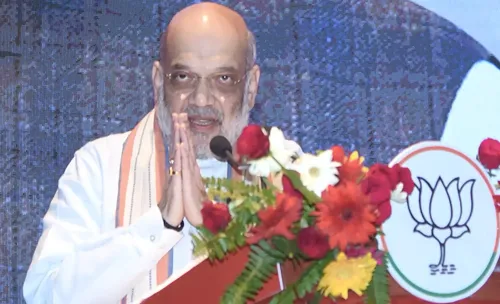What Are the Key Findings from the AAIB Preliminary Report on the Air India Ahmedabad Crash?

Synopsis
Key Takeaways
- Simultaneous engine shutdowns were a major factor in the crash.
- The AAIB’s preliminary report highlights critical cockpit communications.
- There were no hazardous materials or dangerous goods onboard.
- The aircraft was deemed airworthy prior to the flight.
- Air India is fully cooperating with the ongoing investigation.
New Delhi, July 12 (NationPress) While the comprehensive report is expected to take approximately a year, the preliminary insights provided by the Aircraft Accident Investigation Bureau (AAIB) into the tragic incident involving Air India flight AI 171 — a Boeing 787-8 Dreamliner that crashed shortly after take-off from Ahmedabad on June 12 — have unveiled a series of critical findings including simultaneous engine shutdowns, cockpit voice exchanges between the pilots, and additional safety advisories.
The AAIB report indicates that the aircraft was set to operate flight AI171 from Ahmedabad to London-Gatwick.
On June 12, 2025, Air India’s B787-8 aircraft with the registration VT-ANB arrived at Ahmedabad airport after operating flight AI423 from Delhi. The crew from the previous flight had noted a Pilot Defect Report (PDR) entry regarding the status message “STAB POS XDCR” in the Tech Log. Subsequently, troubleshooting was conducted in accordance with the Flight Operations Manual by Air India’s on-duty Aircraft Maintenance Engineer (AME), and the aircraft was deemed fit for flight at 0640 UTC,” the report detailed.
The flight was to be operated by a crew consisting of an Airline Transport Pilot License (ATPL) holder as the Captain, a Commercial Pilot License (CPL) holder as the Co-pilot, along with 10 cabin crew members.
Both pilots were based in Mumbai and arrived in Ahmedabad the previous day, having had an adequate rest period before operating this flight. The co-pilot was designated as the Pilot Flying (PF), while the Captain served as the Pilot Monitoring (PM) for the journey,” the report elaborated.
The AI171 crew completed preflight Breath Analyzer tests and were confirmed fit to undertake the flight. There were 230 passengers onboard, including 15 in business class and 215 in economy class, among them two infants.
The take-off weight was reported to be within allowable limits for the conditions, and there were no ‘Dangerous Goods’ on the aircraft,” according to the AAIB report.
After takeoff, “the aircraft reached a maximum recorded airspeed of 180 Knots IAS at approximately 08:08:42 UTC, after which both Engine 1 and Engine 2 fuel cutoff switches transitioned from RUN to CUTOFF position within a second of each other,” the report emphasized.
As a result, “the Engine N1 and N2 values began to decline from their initial take-off figures due to the interruption of fuel supply,” it added.
The cockpit voice recording indicated that one pilot questioned the other about the fuel cutoff.
“The other pilot replied that he had not performed the action,” it stated.
CCTV footage from the airport captured the deployment of the Ram Air Turbine (RAT) during the initial climb immediately post-lift-off (fig. 15). No significant bird activity was recorded near the flight path. The aircraft began to lose altitude just before reaching the airport perimeter wall.
The aircraft achieved take-off speed at 13:38 IST and lifted off, but just four seconds later, both engines began shutting down. An emergency “Mayday” was declared at 13:39 IST.
While Engine 1 showed potential signs of restarting, Engine 2 failed to regain core speed despite several fuel injections. The aircraft continued its rapid descent. The report ruled out bird strikes or hazardous materials as factors contributing to the incident. There was no visual evidence of birds along the flight path.
The aircraft was deemed airworthy, with an Airworthiness Review Certificate (ARC) valid until May 2026. Both engines had been recently installed in March and May 2025.
A 2018 FAA advisory had previously cautioned about the risk of the fuel control switch lock disengaging. The AAIB report noted that Air India had not taken action on this advisory since it was non-mandatory.
Air India has recognized the AAIB’s preliminary report concerning the AI171 crash, reaffirming its commitment to support the families affected.
“Air India expresses solidarity with the families and individuals impacted by the AI171 incident. We continue to grieve the loss and are dedicated to providing assistance during this challenging time. We acknowledge the preliminary report released by the Aircraft Accident Investigation Bureau (AAIB) on July 12, 2025. Air India is collaborating closely with stakeholders, including regulatory bodies. We remain fully cooperative with the AAIB and other authorities as the investigation unfolds. Due to the ongoing nature of the investigation, we are unable to comment on specific details and direct all inquiries to the AAIB,” the airline stated on X.
Boeing also released a statement in light of the AAIB's preliminary findings: “Our thoughts are with the families of the passengers and crew aboard Air India Flight 171, along with everyone affected on the ground in Ahmedabad. We remain committed to supporting the investigation and our customer. We will defer to the AAIB for information regarding AI171, adhering to the protocol established by the United Nations International Civil Aviation Organization known as Annex 13,” it mentioned.
The AAIB has indicated that, at this stage of the investigation, no recommended actions are being advised for B787-8 and/or GE GEnx-1B engine operators and manufacturers.
“The investigation is ongoing, and the investigative team will continue to review and analyze additional evidence, records, and information being sought from various stakeholders,” it stated, adding that the wreckage and engine components have been relocated to a secure area for further investigation.









